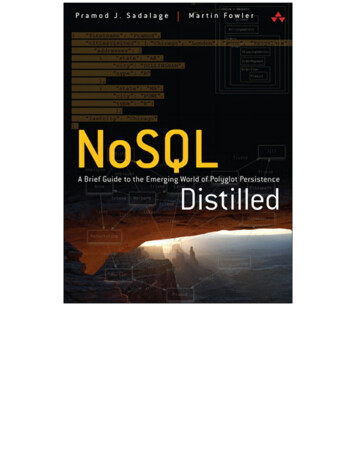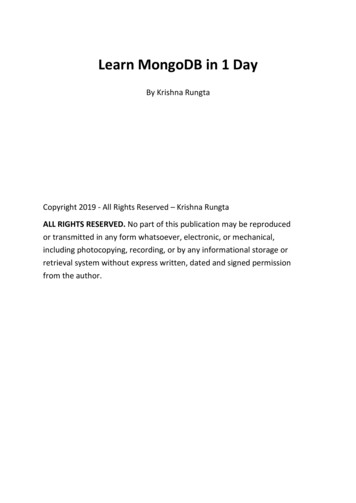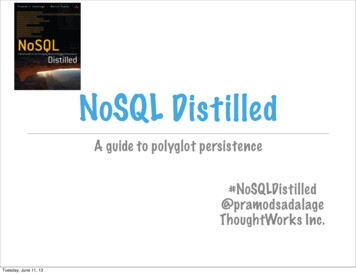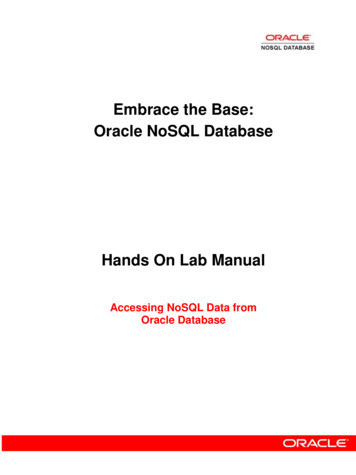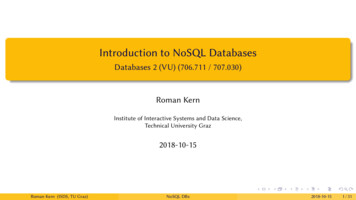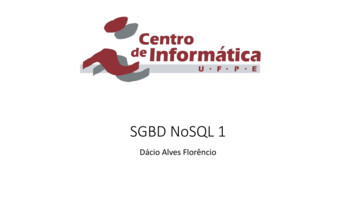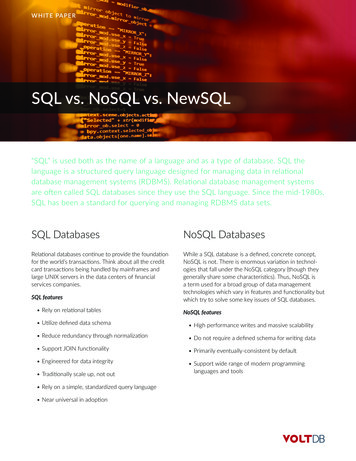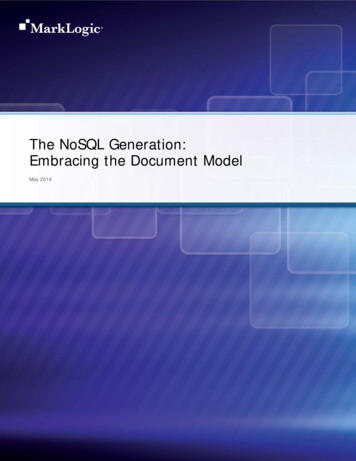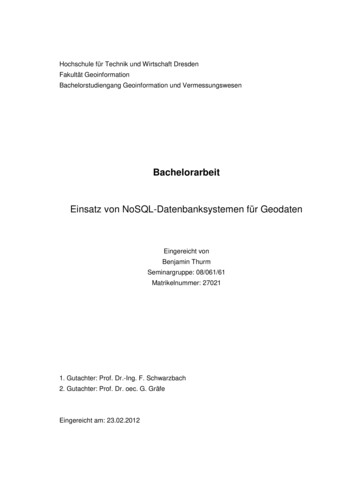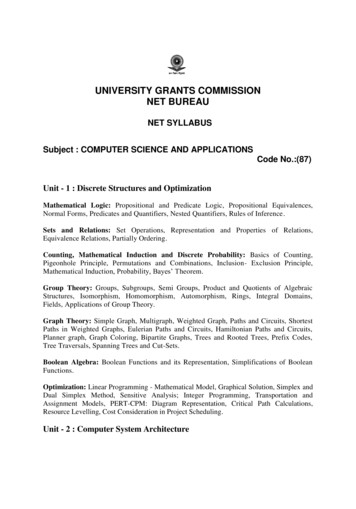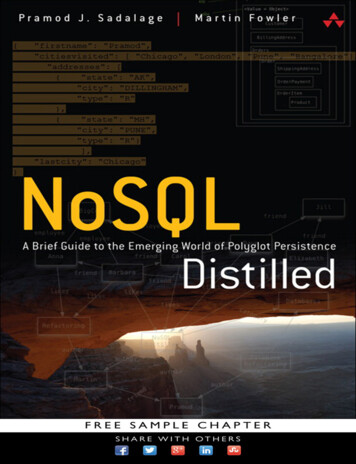
Transcription
NoSQL Distilled
This page intentionally left blank
NoSQL DistilledA Brief Guide to the EmergingWorld of Polyglot PersistencePramod J. SadalageMartin FowlerUpper Saddle River, NJ Boston Indianapolis San FranciscoNew York Toronto Montreal London Munich Paris MadridCapetown Sydney Tokyo Singapore Mexico City
Many of the designations used by manufacturers and sellers to distinguish their products are claimedas trademarks. Where those designations appear in this book, and the publisher was aware of atrademark claim, the designations have been printed with initial capital letters or in all capitals.The authors and publisher have taken care in the preparation of this book, but make no expressedor implied warranty of any kind and assume no responsibility for errors or omissions. No liabilityis assumed for incidental or consequential damages in connection with or arising out of the use ofthe information or programs contained herein.For information about buying this title in bulk quantities, or for special sales opportunities (whichmay include electronic versions; custom cover designs; and content particular to your business,training goals, marketing focus, or branding interests), please contact our corporate sales departmentat corpsales@pearsoned.com or (800) 382–3419.For government sales inquiries, please contact governmentsales@pearsoned.com.For questions about sales outside the U.S., please contact intlcs@pearson.com.Visit us on the Web: informit.com/awLibrary of Congress Cataloging-in-Publication DataSadalage, Pramod J.NoSQL distilled : a brief guide to the emerging world of polyglotpersistence / Pramod J Sadalage, Martin Fowler.p. cm.Includes bibliographical references and index.ISBN 978-0-321-82662-6 (pbk. : alk. paper) -- ISBN 0-321-82662-0 (pbk. :alk. paper) 1. Databases--Technological innovations. 2. Informationstorage and retrieval systems. I. Fowler, Martin, 1963- II. Title.QA76.9.D32S228 2013005.74--dc23Copyright 2013 Pearson Education, Inc.All rights reserved. This publication is protected by copyright, and permission must be obtainedfrom the publisher prior to any prohibited reproduction, storage in a retrieval system, or transmissionin any form or by any means, electronic, mechanical, photocopying, recording, or likewise. Forinformation regarding permissions, request forms and the appropriate contacts within the PearsonEducation Global Rights & Permissions Department, please visit www.pearson.com/permissions/.ISBN-13: 978-0-321-82662-6ISBN-10: 0-321-82662-0ScoutAutomatedPrintCode
For my teachers Gajanan Chinchwadkar,Dattatraya Mhaskar, and Arvind Parchure. You inspiredme the most, thank you.—PramodFor Cindy—Martin
This page intentionally left blank
ContentsPreface . xiiiPart I: Understand . 1Chapter 1: Why NoSQL? . 31.1 The Value of Relational Databases . 31.1.1 Getting at Persistent Data . 31.1.2 Concurrency . 41.1.3 Integration . 41.1.4 A (Mostly) Standard Model . 41.2 Impedance Mismatch . 51.3 Application and Integration Databases . 61.4 Attack of the Clusters . 81.5 The Emergence of NoSQL . 91.6 Key Points . 12Chapter 2: Aggregate Data Models . 132.1 Aggregates . 142.1.1 Example of Relations and Aggregates . 142.1.2 Consequences of Aggregate Orientation . 192.2 Key-Value and Document Data Models . 202.3 Column-Family Stores . 212.4 Summarizing Aggregate-Oriented Databases . 232.5 Further Reading . 242.6 Key Points . 24Chapter 3: More Details on Data Models . 253.1 Relationships . 253.2 Graph Databases . 26vii
chemaless Databases . 28Materialized Views . 30Modeling for Data Access . 31Key Points . 364: Distribution Models . 37Single Server . 37Sharding . 38Leader-Follower Replication . 40Peer-to-Peer Replication . 42Combining Sharding and Replication . 43Key Points . 44Chapter5.15.25.35: Consistency . 47Update Consistency . 47Read Consistency . 49Relaxing Consistency . 525.3.1 The CAP Theorem . 535.4 Relaxing Durability . 565.5 Quorums . 575.6 Further Reading . 595.7 Key Points . 59Chapter6.16.26.36: Version Stamps . 61Business and System Transactions . 61Version Stamps on Multiple Nodes . 63Key Points . 65Chapter7.17.27.37: Map-Reduce . 67Basic Map-Reduce . 68Partitioning and Combining . 69Composing Map-Reduce Calculations . 727.3.1 A Two Stage Map-Reduce Example . 737.3.2 Incremental Map-Reduce . 767.4 Further Reading . 777.5 Key Points . 77Part II: Implement . 79Chapter 8: Key-Value Databases . 818.1 What Is a Key-Value Store . 818.2 Key-Value Store Features . 83
Contents8.2.1 Consistency . 838.2.2 Transactions . 848.2.3 Query Features . 848.2.4 Structure of Data . 868.2.5 Scaling . 868.3 Suitable Use Cases . 878.3.1 Storing Session Information . 878.3.2 User Profiles, Preferences . 878.3.3 Shopping Cart Data . 878.4 When Not to Use . 878.4.1 Relationships among Data . 878.4.2 Multioperation Transactions . 888.4.3 Query by Data . 888.4.4 Operations by Sets . 88Chapter 9: Document Databases . 899.1 What Is a Document Database? . 909.2 Features . 919.2.1 Consistency . 919.2.2 Transactions . 929.2.3 Availability . 939.2.4 Query Features . 949.2.5 Scaling . 959.3 Suitable Use Cases . 979.3.1 Event Logging . 979.3.2 Content Management Systems, Blogging Platforms . 989.3.3 Web Analytics or Real-Time Analytics . 989.3.4 E-Commerce Applications . 989.4 When Not to Use . 989.4.1 Complex Transactions Spanning Different Operations . 989.4.2 Queries against Varying Aggregate Structure . 98Chapter 10: Column-Family Stores . 9910.1 What Is a Column-Family Data Store? . 9910.2 Features . 10010.2.1 Consistency . 10310.2.2 Transactions . 10410.2.3 Availability . 104ix
xContents10.2.4 Query Features . 10510.2.5 Scaling . 10710.3 Suitable Use Cases . 10710.3.1 Event Logging . 10710.3.2 Content Management Systems, Blogging Platforms . 10810.3.3 Counters . 10810.3.4 Expiring Usage . 10810.4 When Not to Use . 109Chapter 11: Graph Databases . 11111.1 What Is a Graph Database? . 11111.2 Features . 11311.2.1 Consistency . 11411.2.2 Transactions . 11411.2.3 Availability . 11511.2.4 Query Features . 11511.2.5 Scaling . 11911.3 Suitable Use Cases . 12011.3.1 Connected Data . 12011.3.2 Routing, Dispatch, and Location-Based Services . 12011.3.3 Recommendation Engines . 12111.4 When Not to Use . 121Chapter 12: Schema Migrations . 12312.1 Schema Changes . 12312.2 Schema Changes in RDBMS . 12312.2.1 Migrations for Green Field Projects . 12412.2.2 Migrations in Legacy Projects . 12612.3 Schema Changes in a NoSQL Data Store . 12812.3.1 Incremental Migration . 13012.3.2 Migrations in Graph Databases . 13112.3.3 Changing Aggregate Structure . 13212.4 Further Reading . 13212.5 Key Points . 132Chapter 13: Polyglot Persistence . 13313.1 Disparate Data Storage Needs . 13313.2 Polyglot Data Store Usage . 13413.3 Service Usage over Direct Data Store Usage . 136
Contents13.413.513.613.713.8Expanding for Better Functionality . 136Choosing the Right Technology . 138Enterprise Concerns with Polyglot Persistence . 138Deployment Complexity . 139Key Points . 140Chapter 14: Beyond NoSQL . 14114.1 File Systems . 14114.2 Event Sourcing . 14214.3 Memory Image . 14414.4 Version Control . 14514.5 XML Databases . 14514.6 Object Databases . 14614.7 Key Points . 146Chapter 15: Choosing Your Database . 14715.1 Programmer Productivity . 14715.2 Data-Access Performance . 14915.3 Sticking with the Default . 15015.4 Hedging Your Bets . 15015.5 Key Points . 15115.6 Final Thoughts . 152Bibliography . 153Index . 157xi
This page intentionally left blank
PrefaceWe’ve spent some twenty years in the world of enterprise computing. We’ve seenmany things change in languages, architectures, platforms, and processes. Butthrough all this time one thing has stayed constant—relational databases storethe data. There have been challengers, some of which have had success insome niches, but on the whole the data storage question for architects has beenthe question of which relational database to use.There is a lot of value in the stability of this reign. An organization’s data lastsmuch longer than its programs (at least that’s what people tell us—we’ve seenplenty of very old programs out there). It’s valuable to have a stable data storagethat’s well understood and accessible from many application programmingplatforms.Now, however, there’s a new challenger on the block under the confrontationaltag of NoSQL. It’s born out of a need to handle larger data volumes which forceda fundamental shift to building large hardware platforms through clusters ofcommodity servers. This need has also raised long-running concerns about thedifficulties of making application code play well with the relational data model.The term “NoSQL” is very ill-defined. It’s generally applied to a number ofrecent nonrelational databases such as Cassandra, Mongo, Neo4J, and Riak.They embrace schemaless data, run on clusters, and have the ability to tradeoff traditional consistency for other useful properties. Advocates of NoSQLdatabases claim that they can build systems that are more performant, scale muchbetter, and are easier to program with.Is this the first rattle of the death knell for relational databases, or yet anotherpretender to the throne? Our answer to that is “neither.” Relational databasesare a powerful tool that we expect to be using for many more decades, butwe do see a profound change in that relational databases won’t be the onlydatabases in use. Our view is that we are entering a world of Polyglot Persistencewhere enterprises, and even individual applications, use multiple technologiesfor data management. As a result, architects will need to be familiar with thesetechnologies and be able to evaluate which ones to use for differing needs.xiii
xivPrefaceHad we not thought that, we wouldn’t have spent the time and effort writingthis book.This book seeks to give you enough information to answer the question ofwhether NoSQL databases are worth serious consideration for your futureprojects. Every project is different, and there’s no way we can write a simple decision tree to choose the right data store. Instead, what we are attempting hereis to provide you with enough background on how NoSQL databases work, sothat you can make those judgments yourself without having to trawl the wholeweb. We’ve deliberately made this a small book, so you can get this overviewpretty quickly. It won’t answer your questions definitively, but it shouldnarrow down the range of options you have to consider and help you understandwhat questions you need to ask.Why Are NoSQL Databases Interesting?We see two primary reasons why people consider using a NoSQL database. Application development productivity. A lot of application developmenteffort is spent on mapping data between in-memory data structures and arelational database. A NoSQL database may provide a data model thatbetter fits the application’s needs, thus simplifying that interaction andresulting in less code to write, debug, and evolve. Large-scale data. Organizations are finding it valuable to capture moredata and process it more quickly. They are finding it expensive, if evenpossible, to do so with relational databases. The primary reason is that arelational database is designed to run on a single machine, but it is usuallymore economic to run large data and computing loads on clusters ofmany smaller and cheaper machines. Many NoSQL databases are designedexplicitly to run on clusters, so they make a better fit for big data scenarios.What’s in the BookWe’ve broken this book up into two parts. The first part concentrates on coreconcepts that we think you need to know in order to judge whether NoSQLdatabases are relevant for you and how they differ. In the second part weconcentrate more on implementing systems with NoSQL databases.
PrefaceChapter 1 begins by explaining why NoSQL has had such a rapid rise—theneed to process larger data volumes led to a shift, in large systems, from scalingvertically to scaling horizontally on clusters. This explains an important featureof the data model of many NoSQL databases—the explicit storage of a richstructure of closely related data that is accessed as a unit. In this book we callthis kind of structure an aggregate.Chapter 2 describes how aggregates manifest themselves in three of the maindata models in NoSQL land: key-value (“Key-Value and Document Data Models,”p. 20), document (“Key-Value and Document Data Models,” p. 20), and columnfamily (“Column-Family Stores,” p. 21) databases. Aggregates provide a naturalunit of interaction for many kinds of applications, which both improves runningon a cluster and makes it easier to program the data access. Chapter 3 shifts tothe downside of aggregates—the difficulty of handling relationships(“Relationships,” p. 25) between entities in different aggregates. This leads usnaturally to graph databases (“Graph Databases,” p. 26), a NoSQL data modelthat doesn’t fit into the aggregate-oriented camp. We also look at the commoncharacteristic of NoSQL databases that operate without a schema (“SchemalessDatabases,” p. 28)—a feature that provides some greater flexibility, but not asmuch as you might first think.Having covered the data-modeling aspect of NoSQL, we move on to distribution: Chapter 4 describes how databases distribute data to run on clusters.This breaks down into sharding (“Sharding,” p. 38) and replication, the latterbeing either leader-follower (“Leader-Follower Replication,” p. 40) or peer-topeer (“Peer-to-Peer Replication,” p. 42) replication. With the distribution modelsdefined, we can then move on to the issue of consistency. NoSQL databasesprovide a more varied range of consistency options than relationaldatabases—which is a consequence of being friendly to clusters. So Chapter 5talks about how consistency changes for updates (“Update Consistency,” p. 47)and reads (“Read Consistency,” p. 49), the role of quorums (“Quorums,” p. 57),and how even some durability (“Relaxing Durability,” p. 56) can be traded off.If you’ve heard anything about NoSQL, you’ll almost certainly have heard ofthe CAP theorem; the “The CAP Theorem” section on p. 53 explains what it isand how it fits in.While these chapters concentrate primarily on the principles of how data getsdistributed and kept consistent, the next two chapters talk about a couple ofimportant tools that make this work. Chapter 6 describes version stamps, whichare for keeping track of changes and detecting inconsistencies. Chapter 7 outlinesmap-reduce, which is a particular way of organizing parallel computation thatfits in well with clusters and thus with NoSQL systems.Once we’re done with concepts, we move to implementation issues by lookingat some example databases under the four key categories: Chapter 8 uses Riakxv
xviPrefaceas an example of key-value databases, Chapter 9 takes MongoDB as an examplefor document databases, Chapter 10 chooses Cassandra to explore columnfamily databases, and finally Chapter 11 plucks Neo4J as an example of graphdatabases. We must stress that this is not a comprehensive study—there are toomany out there to write about, let alone for us to try. Nor does our choice ofexamples imply any recommendations. Our aim here is to give you a feel forthe variety of stores that exist and for how different database technologiesuse the concepts we outlined earlier. You’ll see what kind of code you need towrite to program against these systems and get a glimpse of the mindset you’llneed to use them.A common statement about NoSQL databases is that since they have noschema, there is no difficulty in changing the structure of data during the life ofan application. We disagree—a schemaless database still has an implicit schemathat needs change discipline when you implement it, so Chapter 12 explains howto do data migration both for strong schemas and for schemaless systems.All of this should make it clear that NoSQL is not a single thing, nor is itsomething that will replace relational databases. Chapter 13 looks at this futureworld of Polyglot Persistence, where multiple data-storage worlds coexist, evenwithin the same application. Chapter 14 then expands our horizons beyond thisbook, considering other technologies that we haven’t covered that may also bea part of this polyglot-persistent world.With all of this information, you are finally at a point where you can make achoice of what data storage technologies to use, so our final chapter (“ChoosingYour Database,” p. 147) offers some advice on how to think about these choices.In our view, there are two key factors—finding a productive programmingmodel where the data storage model is well aligned to your application, and ensuring that you can get the data access performance and resilience you need.Since this is early days in the NoSQL life story, we’re afraid that we don’t havea well-defined procedure to follow, and you’ll need to test your options inthe context of your needs.This is a brief overview—we’ve been very deliberate in limiting the size of thisbook. We’ve selected the information we think is the most important—so thatyou don’t have to. If you are going to seriously investigate these technologies, you’ll need to go further than what we cover here, but we hope this bookprovides a good context to start you on your way.We also need to stress that this is a very volatile field of the computer industry.Important aspects of these stores are changing every year—new features, newdatabases. We’ve made a strong effort to focus on concepts, which we think willbe valuable to understand even as the underlying technology changes. We’repretty confident that most of what we say will have this longevity, but absolutelysure that not all of it will.
PrefaceWho Should Read This BookOur target audience for this book is people who are considering using some formof a NoSQL database. This may be for a new project, or because they are hittingbarriers that are suggesting a shift on an existing project.Our aim is to give you enough information to know whether NoSQL technology makes sense for your needs, and if so which tool to explore in more depth.Our primary imagined audience is an architect or technical lead, but we thinkthis book is also valuable for people involved in software management who wantto get an overview of this new technology. We also think that if you’re a developer who wants an overview of this technology, this book will be a good startingpoint.We don’t go into the details of programming and deploying specific databaseshere—we leave that for specialist books. We’ve also been very firm on a pagelimit, to keep this book a brief introduction. This is the kind of book we thinkyou should be able to read on a plane flight: It won’t answer all your questionsbut should give you a good set of questions to ask.If you’ve already delved into the world of NoSQL, this book probably won’tcommit any new items to your store of knowledge. However, it may still beuseful by helping you explain what you’ve learned to others. Making sense ofthe issues around NoSQL is important—particularly if you’re trying to persuadesomeone to consider using NoSQL in a project.What Are the DatabasesIn this book, we’ve followed a common approach of categorizing NoSQLdatabases according to their data model. Here is a table of the four data modelsand some of the databases that fit each model. This is not a comprehensive list—itonly mentions the more common databases we’ve come across. At the time ofwriting, you can find more comprehensive lists at http://nosql-database.org andhttp://nosql.mypopescu.com/kb/nosql. For each category, we mark with italicsthe database we use as an example in the relevant chapter.Our goal is to pick a representative tool from each of the categories of thedatabases. While we talk about specific examples, most of the discussion shouldapply to the entire category, even though these products are unique and cannotbe generalized as such. We will pick one database for each of the key-value,document, column family, and graph databases; where appropriate, we willmention other products that may fulfill a specific feature need.xvii
xviiiPrefaceData ModelExample DatabasesKey-Value (“Key-Value Databases,” p. 81)BerkeleyDBLevelDBMemcachedProject VoldemortRedisRiakDocument (“Document Databases,” p. amily (“Column-Family Stores,” p. 99)Amazon SimpleDBCassandraHBaseHypertableGraph (“Graph Databases,” p. 111)FlockDBHyperGraphDBInfinite GraphNeo4JOrientDBThis classification by data model is useful, but crude. The lines between thedifferent data models, such as the d
The term "NoSQL" is very ill-defined. Its generally applied to a number of' recent nonrelational databases such as Cassandra, Mongo, Neo4J, and Riak. They embrace schemaless data, run on clusters, and have the ability to trade off traditional consistency for other useful properties. Advocates of NoSQL
